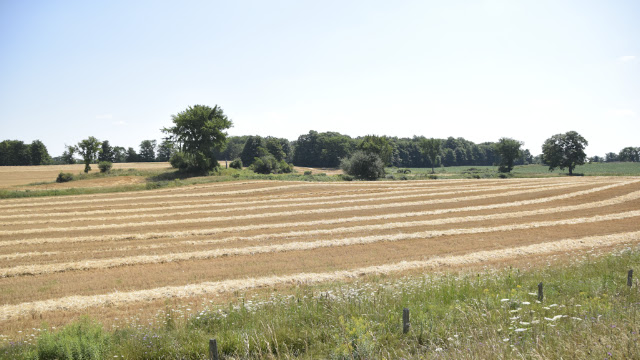At this time of the year I'm constantly noticing the crops as they mature around here. As older farmers retire, quite often farms get turned over to cash crops, and the big three here are corn, soybeans and wheat. The wheat harvest definitely marks August and I managed to get a few pictures on our drive to Keady Market.
The corn is ripening nicely now, with lots of tassels on this crop. Almost all of the corn grown here is field corn, intended for animal feed, but some of it may be ground up for silage while other times the cobs will be harvest for grain, that harvest usually being the last crop harvest of fall.At this time of year soybeans are just a rolling field of green, soon to start turning yellow. Only the beans are eventually harvested, for canola oil.
But it's the wheat harvest going on now, often harvested by roving crews with huge combines, so farmers don't have to buy their own frightfully expensive equipment. I didn't catch a combine at work this year, so this one is from the past. With equipment this big it is quick work to finish a field, so I've had to be lucky to see one actually at work.
After the combine has gone through harvesting the grain, only the stems of the plants are left, but they have to be raked into rows before the straw can be baled. Straw has low nutritional value because the grain (with all the protein) has been separately harvested, unlike hay where all the seeds of the grasses are included, making it better feed for cattle.
Once the straw has been raked it can be baled. Around here it's usually baled into large round bales, often just because the farmer has a large round baler and that's what they're used to handling.
Then they are laboriously gathered in rows so they can be easily pick up and loaded onto wagons for a ride back to the farmyard. Large round bales of hay usually get wrapped in white plastic here, to protect them until they're used for feed, but straw is often left unwrapped and just used for bedding, only fed at the end of the winter if the farmer runs out of hay.
So that's a quick look at the big three cash crops around here.







Those fields with the bales this time of year are some of favourite farming scenes.
ReplyDeleteNot too much different here, but there is a sunflower field that I want to visit once we can get out of the house.
ReplyDeleteI'm old enough to have driven a tractor with an old-fashioned binder behind when I was a girl. And the threshing crews that made the rounds. Feeding them was an enormous job for my Mom and myself.
ReplyDeleteHardly anyone remembers those times any more.
Our fields around us also are entertaining. You've summed things up nicely in the soybean and wheat processes.
ReplyDeleteFarmers here grow corn and soybean. Most of the corn goes to feeding the animals.
ReplyDeleteIt’s that time of year! Summer is passing so quickly.
ReplyDeleteThis comment has been removed by a blog administrator.
ReplyDeleteWe didn't have animals to feed (other than a few cats and a dog), so Dad didn't have the straw baled. He would use the harrows to pile the straw up in small piles around the field, and then on a calm evening, we'd burn the files. As a youngster I enjoyed the thrill of watching the piles burn, and we had pitchforks to ensure the hay didn't blow away if a gust of wind came up.
ReplyDeleteOur major crops were wheat, barley, and canola (formerly called rapeseed). Dad did grow some clover as well, and occasionally a field of flax.
I think you look like you are just like Iowa farmers. It looks like you get better rains than we do. The wheat we don't do. My dad did corn and beans for years.
ReplyDeleteSummer is quickly coming to an end now. Except for some Amish and old-order Mennonites there are few dairy farms remaining here, but even some of them have given up milking cows. Dairy farming is just too much work and investment for very little return, not to mention it's a seven day a week, 365 days a year job for a small dairy farmer, the farms milking 3,000 cows have many employees so everyone can have days off and a vacation.
ReplyDeleteIt is a busy time of year on the farms.
ReplyDeleteAn informative way of explaining our summer crops here in Ontario. I've noticed all three crops are looking very robust and healthy this year. Bumper crops come to mind..
ReplyDelete